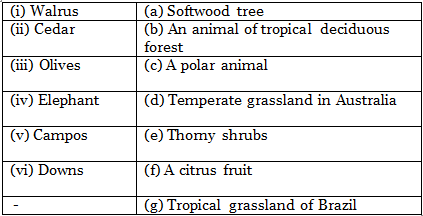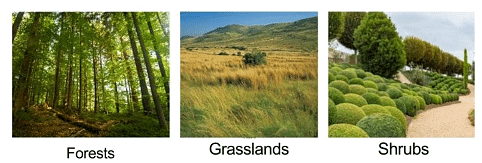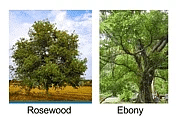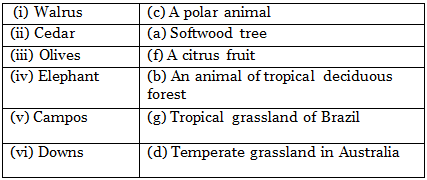NCERT Solutions for Class 9 Geography Chapter 5 - Natural Vegetation and Wildlife
Answer the following questions
Q.1. Which are the two factors on which the growth of vegetation mostly depends?
The two factors on which the growth of vegetation mostly depends are:
(i) Climate (Temperature and Moisture)
(ii) The thickness of the soil.
Q.2. Which are the three broad categories of natural vegetation?
The three broad categories of natural vegetation are forests, grasslands and shrubs.
(i) Forests: Forests are dense growths of trees, plants, and other vegetation that form a complex ecosystem. They are found in regions with high rainfall, and the trees are usually tall and evergreen.
(ii) Grasslands: Grasslands are large open areas characterized by the dominance of grasses rather than trees or shrubs. They occur in regions where rainfall is moderate and not enough to support the growth of dense forests.
(iii) Shrubs: Shrublands, also known as scrublands or bushlands, are characterized by the dominance of shrubs, which are small to medium-sized woody plants with multiple stems.
Q.3. Name the two hardwood trees commonly found in tropical evergreen forest.
Rosewood and ebony are hardwood trees commonly found in tropical evergreen forests.
Q.4. In which part of the world are tropical deciduous forests found?
Tropical deciduous forests are monsoon forests found in following parts of world:
(i) Large parts of India,
(ii) Northern Australia
(iii) Central America.
Q.5. In which climatic conditions are citrus fruits cultivated?
Citrus fruits are cultivated in Mediterranean climate, i.e., regions experiencing hot, dry summers and mild, rainy winters.
Q.6. Mention the uses of coniferous forest.
Uses of Coniferous forests are:
(i) Softwood tree wood is used for making pulp.
(ii) Pulp is utilized in manufacturing paper and newsprint.
(iii) Softwood is used in the production of matchboxes.
(iv) Packing boxes are made from softwood derived from coniferous forests.
Q.7. In which part of the world is seasonal grassland found?
Seasonal grassland is found in the Savannah region of Africa, in the mid-latitudinal zones, and in the interior parts of continents.
Choose the correct answer
Q.1. Mosses and lichens are found in
(a) Desert Vegetation
(b) Tropical evergreen forest
(c) Tundra vegetation
Correct Answer is option (c)
Tundra vegetation comprises hardy, low-growing plants like mosses, lichens, and small shrubs that can survive extreme cold, long winters, and short growing seasons.
Tundra Vegetation
Q.2. Thorny bushes are found in
(a) Hot and humid tropical climate
(b) Hot and dry desert climate
(c) Cold polar climate
Correct Answer is option (c)
Thorny bushes are found in hot and dry desert climates because their thorns help to reduce water loss by minimizing the surface area exposed to the sun and protect the plant from being eaten by herbivores in an environment with limited resources.
Q.3. In tropical evergreen forest, one of the common animals is
(a) Monkey
(b) Giraffe
(c) Camel
Correct Answer is option (a)
Commonly found animals in tropical evergreen forests are monkeys, jaguars, sloths, toucans, parrots, snakes, and frogs.
Q.4. One important variety of coniferous forest is
(a) Rosewood
(b) Pine
(c) Teak
Correct Answer is option (b)
Pine forests are a type of forest ecosystem dominated by pine trees, which are evergreen, coniferous plants. Pine forests can be found in various regions across the world, from North America and Europe to Asia and northern Africa, but they are most commonly found in mountainous areas and regions with colder climates.
Pine Trees
Q.5. Steppe grassland is found in
(a) S. Africa
(b) Australia
(c) Russia
Correct Answer is option (c)
Steppe grasslands are vast, semi-arid flatland ecosystems dominated by a mix of grasses and herbaceous plants. They can be found in temperate regions, such as Central Asia and Eastern Europe, with a moderate climate and minimal precipitation.
Steppe Grassland
Match the following
Q.1. Match the following.
Walrus → A Polar Animal
The walrus, an animal predominantly found in the polar region, is well-adapted to thrive in such conditions.Cedar → Softwood tree
The cedar tree, predominantly found in coniferous forests, is a type of softwood.Olives → Softwood tree
Citrus fruits like olives can be found in Mediterranean regions.Elephant → An animal of tropical deciduous forest
Elephants can be found in tropical deciduous forests.Campos → Tropical grassland of Brazil
The tropical grasslands are known as the Campos in Brazil.Downs → Temperate grassland in Australia
The temperate grasslands are known as the Downs in Australia
Give Reasons
Q.1. The animals in Polar region have thick fur and thick skin.
The animals in Polar region have thick fur and thick skin because of following reasons:
(i) Insulation: The thick fur and skin of animals in the Polar region act as insulation to protect them from extreme cold temperatures. It helps to retain their body heat and prevent heat loss to the surrounding environment.(ii) Buoyancy in water: Some animals in the Polar region, like seals and walruses, have thick skin that helps them stay buoyant in water. It provides natural buoyancy and insulation while swimming and diving in the icy waters.
(iii) Waterproofing: Many animals in the Polar region have fur with specialized adaptations that make it water-resistant or waterproof. This feature helps to keep their bodies dry, even when they come into contact with snow, ice, or water, reducing the risk of hypothermia.
Q.2. Tropical deciduous trees shed their leaves in the dry season.
Tropical deciduous trees shed their leaves in the dry season because of following reasons:
(i) Adaptation to drought: The dry season in tropical regions is often characterized by limited water availability. By shedding their leaves, deciduous trees reduce water loss through transpiration. Transpiration is the process by which plants lose water through their leaves. By shedding leaves, the trees minimize water loss and conserve moisture during the dry period when water supply is limited.(ii) Conservation of energy: Leaves are the primary sites of photosynthesis, where plants convert sunlight into energy. During the dry season, when sunlight may be intense but water availability is low, it becomes challenging for trees to maintain the necessary water balance for photosynthesis. By shedding leaves, deciduous trees conserve energy by temporarily halting photosynthesis and redirecting resources towards survival during the dry period.
Q3: The type and thickness of vegetation changes from place to place.
The type and thickness of vegetation changes from place to place due to:
(i) Climate: Different types of vegetation are adapted to specific climatic conditions, including temperature, rainfall, and sunlight.
(ii) Soil Composition: The type and fertility of soil influence the growth and density of vegetation in an area.
(iii) Topography: The physical features of the land, such as elevation and slope, affect the distribution and density of vegetation.
(iv) Water Availability: The presence or scarcity of water resources influences the type and abundance of vegetation in an area.
(v) Human Influence: Human activities, like deforestation and urbanization, can alter the natural vegetation and introduce cultivated or artificial landscapes.
(vi) Biotic Interactions: Interactions among organisms, such as competition and predation, can impact the distribution and density of vegetation.
FAQs on NCERT Solutions for Class 9 Geography Chapter 5 - Natural Vegetation and Wildlife
| 1. What is natural vegetation and wildlife? |  |
| 2. What are the types of natural vegetation found in India? |  |
| 3. What are the major threats to natural vegetation and wildlife in India? |  |
| 4. How can we conserve natural vegetation and wildlife in India? |  |
| 5. What is the significance of natural vegetation and wildlife? |  |




















